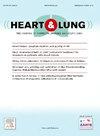感染性心内膜炎住院患者的住院结局和再入院率的社会经济差异:来自美国的一项全国性分析
IF 2.6
4区 医学
Q2 CARDIAC & CARDIOVASCULAR SYSTEMS
引用次数: 0
摘要
背景:当前数据阐明了心血管相关住院患者不良结局与低社会经济地位(SES)之间的关联。尽管如此,SES状态对感染性心内膜炎(IE)结局的影响尚不清楚。目的评价SES对IE住院患者的影响。方法:我们查询全国再入院数据库(2016-2020),确定成人IE患者,并根据平均收入四分位数(≤2四分位数vs≥3四分位数)对其进行分层。主要终点是住院死亡率。次要结局包括30天和90天再入院、败血症、机械循环支持(MCS)的使用、急性肾损伤(AKI)、起搏器和瓣膜置换术干预、住院时间(LOS)和总住院费用。校正混杂因素的多变量回归模型。结果在41,175例IE住院患者中,低收入患者占24,581例(59.7%)。与高收入人群相比,低收入人群住院死亡率(aOR 1.21, 95% CI 1.04-1.41, p = 0.012)、30天再入院率(aOR 1.09, 95% CI 1.01-1.17, p = 0.021)、90天再入院率(aOR 1.1, 95% CI 1.02-1.19, p = 0.012)、败血症(aOR 1.11, 95% CI 1.03-1.19, p = 0.008)、MCS使用率(aOR 1.48, 95% CI 1.04-2.09, p = 0.027)和卒中发生率(aOR 0.86, 95% CI 0.78-0.96, p = 0.005)较高。两个收入组在AKI、瓣膜置换术干预、起搏器使用、平均LOS和总医院费用方面均无差异。结论:在IE住院患者中,与高收入人群相比,低收入人群的住院死亡率和非致命性不良后果发生率更高。本文章由计算机程序翻译,如有差异,请以英文原文为准。
Socioeconomic disparities in In-hospital outcomes and readmission rates among patients hospitalized with infective endocarditis: A national analysis from the United States
Background
Contemporary data elucidates an association between adverse outcomes and low socioeconomic status (SES) in patients with cardiovascular related hospitalizations. Despite this, the impact of SES status on infective endocarditis (IE) outcomes remains unknown.
Objectives
To assess the impact of SES on hospitalized IE cases.
Methods
We queried the Nationwide Readmission Database (2016–2020) to identify adult patients with IE and stratified them based on mean income quartiles (≤2 quartile vs. ≥3 quartiles). The primary outcome was in-hospital mortality. Secondary outcomes included 30-day and 90-day readmissions, sepsis, mechanical circulatory support (MCS) use, acute kidney injury (AKI), pacemaker and valve replacement interventions, length of stay (LOS), and total hospital charges. Multivariable regression models adjusted for confounders.
Results
Among 41,175 IE hospitalizations, 24,581 (59.7 %) included patients with low income. Low income was associated with higher odds of in-hospital mortality (aOR 1.21, 95 % CI 1.04–1.41, p = 0.012), 30-day readmissions (aOR 1.09, 95 % CI 1.01–1.17, p = 0.021), 90-day readmissions (aOR 1.1, 95 % CI 1.02–1.19, p = 0.012), sepsis (aOR 1.11, 95 % CI 1.03–1.19, p = 0.008), MCS use (aOR 1.48, 95 % CI 1.04–2.09, p = 0.027) and lower odds of stroke (aOR 0.86, 95 % CI 0.78–0.96, p = 0.005) compared with high-income. No differences were observed in odds of AKI, valve replacement intervention, pacemaker use, mean LOS and total hospital charges between both income groups.
Conclusion
Among IE hospitalizations, lower income was associated with higher odds of in-hospital mortality and non-fatal adverse outcomes compared to higher income individuals.
求助全文
通过发布文献求助,成功后即可免费获取论文全文。
去求助
来源期刊

Heart & Lung
医学-呼吸系统
CiteScore
4.60
自引率
3.60%
发文量
184
审稿时长
35 days
期刊介绍:
Heart & Lung: The Journal of Cardiopulmonary and Acute Care, the official publication of The American Association of Heart Failure Nurses, presents original, peer-reviewed articles on techniques, advances, investigations, and observations related to the care of patients with acute and critical illness and patients with chronic cardiac or pulmonary disorders.
The Journal''s acute care articles focus on the care of hospitalized patients, including those in the critical and acute care settings. Because most patients who are hospitalized in acute and critical care settings have chronic conditions, we are also interested in the chronically critically ill, the care of patients with chronic cardiopulmonary disorders, their rehabilitation, and disease prevention. The Journal''s heart failure articles focus on all aspects of the care of patients with this condition. Manuscripts that are relevant to populations across the human lifespan are welcome.
 求助内容:
求助内容: 应助结果提醒方式:
应助结果提醒方式:


